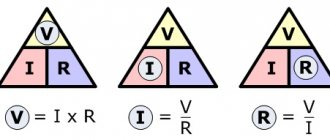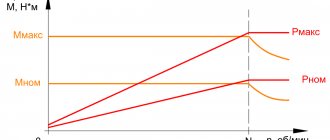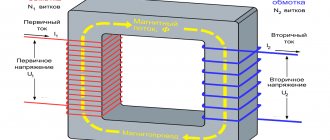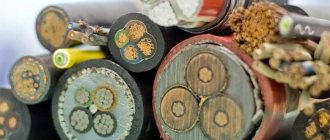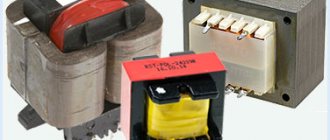Transformer power concept
An AC transformer does not produce electrical energy, but only converts it in magnitude. Therefore, its power completely depends on its load (current consumption) of the secondary circuit. If there are several consumers, the total load that can be connected simultaneously must be taken into account. For AC circuits, the active and reactive nature of consumption is taken into account.
Active
This component of the characteristic is defined as the average instantaneous value over a certain period of time. For sinusoidal alternating current circuits, the value of the oscillation period is used as a period of time:
T=1/f,
where f is frequency.
The active part depends on the nature of the load, that is, on the phase shift between current and voltage and is determined by the formula:
P=i∙U∙cosϕ,
where ϕ is the phase shift angle.
The active component of AC devices is expressed in Watts, as for DC circuits.
Reactive
A reactive load differs from an active load in that during one period of voltage fluctuations, electrical energy is not actually consumed, but is returned. As a result of the fact that devices with large capacitance or inductance (electric motors) are connected to the power supply device, a phase shift occurs between the current and voltage.
The reactive component of consumption is determined by the expression:
Q= i∙U∙sinϕ
The unit of measurement is var (volt-ampere reactive).
Full
The total power of the transformer takes into account all consumed and returned energy and is found from the expression:
S= i∙U
All components are related by the relationship:
S2=P2+Q2.
The unit of measurement is VA (volt-ampere).
Apparent power equals active power only in the case of a fully active load.
Nominal
The rated power of the transformer takes into account the possibility of operation of the structure, taking into account the connection of consumers of different types, that is, it is similar to the full one. At the same time, proper operation of the device is guaranteed for the entire declared service life under the specified operating conditions.
Rated power, like total power, takes into account the active and reactive nature of consumption, which can change during operation.
Expressed in volt-amperes.
What is the load?
The load can be resistive, in which almost all the power is expended on the operation of the electrical appliance. For example, in order for an electric kettle to heat up, the heating elements located inside it, when current passes, take exactly as much electricity as indicated in the characteristics. The resistive power of electrical appliances is indicated in kW.
With an inductive load, some of the electricity is consumed to create an electromagnetic field. For example, in engines. Therefore, it is costly to thoroughly calculate exactly how much electricity is needed to rotate the engine.
There is also such a thing as a mixed load. There are several types of loads present here at the same time. Most modern electrical appliances work exactly according to this scheme.
Methodology for calculating transformer power
When calculating the power transformer of the supply substation, the average daily load and the duration of the period of maximum consumption are taken into account. In this case, the following ratio should be taken into account:
Snom≥∑Pmax
The peak consumption mode must also take into account the exposure time, since with short-term bursts (up to 1 hour), the device will operate in an underloaded mode, which is not economically profitable.
In such cases, it is necessary to take into account the overload capacity of the structure, which depends on design features, ambient temperature and cooling conditions. This is dictated by the conditions of permissible heating of the constituent elements (windings, switching circuits).
The concept of load factor defines the ratio of average daily and maximum consumption of electrical energy. The load factor is always less than one. Its value is related to the requirements for the reliability of power supply. The lower the required reliability, the more the coefficient can approach unity.
Main Russian and foreign manufacturing plants of power and distribution transformers
Works [3, 4] provide an analysis of the state of the Russian market for power and distribution transformers (25 kVA - 6300 kVA) in terms of the need for these transformers and list the main manufacturing plants in Russia and the CIS. The demand forecast and plant details are shown in Tables 1 and 2.
Table 1 . Data on the main manufacturing plants of dry-type and oil-immersed transformers of sizes I–III in Russia and the CIS
| No. | Name of legal entity of the manufacturer, city, manager | Approximate production volume, pieces per year (in 2022) | Assortment list of distribution transformers |
| 1 | Transformer LLC Reshetnikov Ivan Valerievich 142104, Moscow region, Podolsk, Bolshaya Serpukhovskaya street, building 43 building 101, extension 840 room 1 2015 | 1400 | Dry and oil transformers of all types |
| 2 | Elektroshield Samara 443048, Samara region, Samara city, territory of JSC Electroshield 2003 Managing organization NJSC "SESH Holding" Shatunin Vladimir Vitalievich 443048, Samara region, city of Samara, territory of JSC Elektroshield 2019 | No data | Dry and oil transformers of all types |
| 3 | JSC "ELECTROSHIELD" Grigoriev Anton Valerievich 142324, Moscow region, Chekhov city, Lyutoretskoye village, Proizvodstvennaya street, property 1 2002 | 1100 | Oil transformers and dry cast resin transformers |
| 4 | Togliatti Transformer LLC Chistyakov Vladimir Sergeevich 445035, Samara region, Togliatti | 1300 (only TMG type transformers) | Oil transformers |
| 5 | SVEL-Power Transformers LLC 620010, Sverdlovsk region, Yekaterinburg Managing organization JSC SverdlovElectro GROUP Alexey Yuryevich Kishko 620010, Sverdlovsk region, Yekaterinburg | No data | Dry-type cast resin transformers |
| 6 | OJSC "Altai Transformer Plant" Alexander Alexandrovich Karlov 656016, Altai Territory, Barnaul city, Pavlovsky tract, 28 2002 | 10 000 | Oil transformers |
| 7 | LLC "Electrophysics" Alexey Evgenievich Volkov 196641, St. Petersburg, Metallostroy village | 1 000 | Dry transformers with air barrier insulation |
| 8 | METZ named after. V. I. Kozlova Radevich Alexander Mikhailovich st. Uralskaya, 4, office. 502 220037, Minsk Republic of Belarus 1956 | 24 000 | Oil and dry transformers of all types |
| 9 | JSC "Kentau Transformer Plant" Kozhabaev Khairulla Baydildayevich Republic of Kazakhstan, Turkestan region, Kentau, st. I. Kozhabaeva 2 1959 (bought by a private owner in 1997) | 10,000 (volume of exports to CIS countries) | Oil and dry transformers of all types |
| 10 | Ural Transformer Plant LLP Sauranbaev Akzhol Nartaevich Republic of Kazakhstan, Uralsk st. Yesenzhanova 42/6N1 2014 | 9,000 (volume of exports to CIS countries) | Oil transformers and dry type with cast insulation |
| 11 | LLC PC "SlavEnergo" Vladimir Aleksandrovich Kozlov 150031, Yaroslavl region, Yaroslavl city | Less than 1000 pieces per year | Dry-type transformers with cast and air barrier insulation |
| 12 | LLC Butylkin Alexander Borisovich 623750, Sverdlovsk region, Rezhevsky district, city of Rezh | Less than 1000 pieces per year | Oil transformers |
| 13 | Ferroma LLC Linev Dmitry Sergeevich 187330, Leningrad region, Kirovsky district, Otradnoye city | Less than 1000 pieces per year | Dry-type cast resin transformers |
| 14 | LLC "Plant Elektromashina" Butorov Alexander Pavlovich 650044, Kemerovo Region - Kuzbass region, Kemerovo city | Less than 1000 pieces per year | Dry-type transformers with cast and air barrier insulation |
| 15 | LLC "Kurgan Power Transformers Plant" Mostovskikh Sergey Aleksandrovich 640007, Kurgan region, Kurgan city | Less than 1000 pieces per year | Oil and dry cast resin transformers |
| 16 | Proektelectrotechnika LLC 429122, Chuvash Republic - Chuvashia, Shumerlya Managing organization Proekt-Tekhnika Corporation LLC 125362, Moscow Bekbulatov Igor Akhmedovich | Less than 1000 pieces per year | Dry-type cast resin transformers |
Table 2 . Forecast of the required quantity of oil-based and dry-type transformers for 2021-2022.
| Transformer power, kVA | Total requirement, pieces | Demand for oil transformers, pieces | Requirement for dry transformers, pieces |
| 25 | 34881 | 27905 | 6976 |
| 40 | 12856 | 10285 | 2571 |
| 63 | 7170 | 5736 | 1434 |
| 100 | 4738 | 3790 | 948 |
| 160 | 3436 | 2749 | 687 |
| 250 | 2643 | 2114 | 529 |
| 400 | 2117 | 1694 | 423 |
| 630 | 1746 | 1397 | 349 |
| 1000 | 1474 | 1179 | 295 |
| 1600 | 1266 | 1013 | 253 |
| 2500 | 1104 | 883 | 221 |
| 4000 | 974 | 779 | 195 |
| 6300 | 868 | 694 | 175 |
| Total | 75274 | 60218 | 15056 |
However, in addition to the factories listed in Table 1, there are many small enterprises in Russia that assemble transformers from foreign components. Components are most often purchased from Italy, Germany, Turkey, South Korea and China. Many small transformer factories partially manufacture the main components of transformers themselves (windings, magnetic cores, tanks), and partially purchase them from large factories.
There are also foreign manufacturers of power and distribution transformers on the Russian transformer market. In addition to well-known brands such as ABB, Schneider Electric, Siemens, transformers from lesser-known manufacturers from Italy, the Czech Republic, and Turkey are also in great demand. The bulk of foreign suppliers are presented on the resources indicated in references [5 - 11].
It is necessary to note that, despite the general theoretical and methodological apparatus for designing transformers, each country and each enterprise has developed its own engineering schools and its own nuances in the production of transformers. The source of these differences lies, in particular, in different standards, in different operating conditions of transformers in different countries, in different levels of design and technological discipline of enterprises in different countries. All this ultimately leads to the fact that foreign transformer equipment does not always work properly when used in our country.
With such a variety of transformer manufacturers on the market, there is a need for tools that allow you to compare transformers of equal power with each other in order to select the best option, both in technical terms and in cost.
Examples of real calculations
As an example, you can choose the supply substation of a residential area. The substation load is category III, so the load factor can be selected from a higher value - 0.9-0.95.
The nature of current consumption in the household sector depends on the time of day and season, but given the high load factor, it is permissible to take into account the average value of power consumption. To increase operational reliability during periods of maximum consumption, it is recommended to use oil-filled transformers, which have a high overload capacity for a long period of time (30% overload for 2 hours).
Tables
Specific cost of electricity transformation (oil conventional transformers), rub./kWh/year
Specific cost of electricity transformation (oil-based energy-efficient transformers), rub./kWh/year
Specific cost of electricity transformation (dry conventional transformers), rub./kWh/year
Specific cost of electricity transformation (dry energy-efficient transformers), rub./kWh/year
Total discounted cost of ownership (oil-filled conventional transformers), thousand rubles.
Total discounted cost of ownership (oil-based energy-efficient transformers), thousand rubles.
Payback period (energy-efficient oil-based compared to conventional oil-based), years.
Total discounted cost of ownership (dry conventional transformers), thousand rubles.
Total discounted cost of ownership (dry energy efficient transformers), thousand rubles.
Payback period (dry energy efficient compared to dry conventional), years.
Transformer design sketch
The design of a powerful power transformer consists of several parts:
- Skeleton
- Removable part.
The removable part includes the core itself and windings with an active part, which includes switches with drives, high and low voltage inputs, and safety devices.
The core is the main component of the design of the active part. The frame includes a magnetic system (core) with all windings, as well as structural elements for fastening and connecting windings and parts of the magnetic system.
Compensation
Considering that when the currents resonate, the reactive power is 0:
Q = QL – QC = ULI – UCI
In order to improve the quality of operation of a particular device, special devices are used to minimize the impact of losses on the network. In particular, this is a UPS. This device does not require electrical consumers with a built-in battery (for example, laptops or portable devices), but for most others an uninterruptible power supply is necessary.
When installing such a source, you can not only determine the negative consequences of losses, but also reduce the cost of paying for electricity. Experts have proven that on average, a UPS will help save from 20% to 50%. Why is this happening :
- The load on power transformers is significantly reduced;
- The wires heat up less, this not only has a positive effect on their operation, but also increases safety;
- Signaling and radio devices have reduced interference;
- Harmonics in the electrical network are reduced by an order of magnitude.







